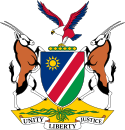|
2015 Namibian local and regional elections
Namibia held elections for their local and regional councils on 27 November 2015.[1] Ballots were cast using electronic voting.[2] Electoral systemElections to regional councils are held using the first-past-the-post electoral system. Voters in each constituency elect one councillor to represent them on their regional council. Local authority councillors are elected by a system of proportional representation.[3] ResultsRegional and local elections taken together elected 199 women out of the 499 available seats,[4] partly because affirmative action for women is required by law in local authority elections.[3] Regional electionsThere were 121 constituency councillors to be elected. Each of them represented their constituency in the respective regional council.[3] The regional councils in turn selected 3 representatives each to serve in the National Council. In twenty-eight constituencies SWAPO was announced as winner in October because no opposition party nominated a candidate.[1][5]
Local electionLocal elections determine the population of the village, town, and city councils and have a direct influence on who will become mayor, as this position is elected among all councillors. Contrary to the regional elections, local elections in Namibia are determined by party, not by individual. There are 57 local authorities to be elected. In five of them (Okahao, Omuthiyagwiipundi, Oniipa, Outapi and Tsandi) SWAPO was announced as winner in October because no opposition party nominated a candidate.[1][6] References
|
|||||||||||||||||||||||||||||||||||
Portal di Ensiklopedia Dunia
